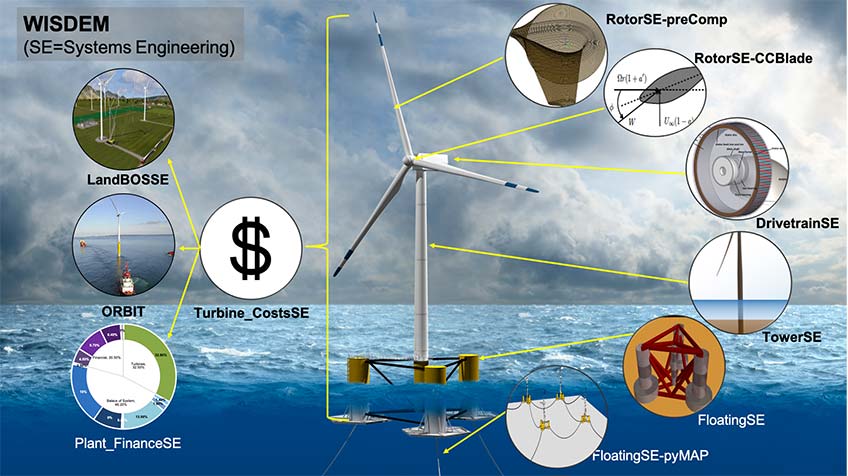Moving Beyond Conventional WISDEM: Open-Source Software Upgrades User Experience

Armed with WISDEM®, the entire wind industry value chain stands to win.
Developed by the National Renewable Energy Laboratory (NREL), the Wind Plant Integrated Systems Design and Engineering Model (WISDEM) software creates a virtual, vertically integrated wind plant from components to operations.
This core systems engineering software tool captures important system interactions to achieve a better understanding of how to improve system-level performance and reduce costs. WISDEM couples engineering and cost models to make system-level tradeoffs, helping engineers see the big picture.
Recent updates to the WISDEM code put the user experience front and center.
The NREL systems engineering team is pleased to announce a major release of the WISDEM code that constitutes a complete overhaul of how the user interacts with WISDEM and how the WISDEM modules couple with each other.
“Previously, WISDEM users had to know Python, be familiar with the NASA OpenMDAO software that WISDEM is built upon, and frequently dive into the source code since there was little documentation,” said NREL Researcher Garrett Barter. “We spent a lot of time writing documentation, automated checks to catch bugs, and overhauling how users run WISDEM to remove Python from the experience. A lot of credit for this work goes out to the NREL WISDEM development team of Pietro Bortolotti, John Jasa, and Alicia Key.”
From the development of a cohesive documentation guide to the inclusion of example case studies, WISDEM Version 3.2 software offers several notable enhancements:
- Documentation: Materials include an introduction to WISDEM’s capabilities, a getting-started guide, a tour through examples, and more.
- Example problems: Comprising 12 numbered examples to acclimate new users to WISDEM case studies, these example files serve as building blocks for more complex studies and are useful for both new and experienced users.
- YAML-based inputs: Three separate YAML (a human-readable structured data format) input files—Geometry, Modeling, and Analysis—allow users to employ WISDEM without knowing Python.
- Graphical user interface to YAMLs: The recent upgrade gives users the option of applying a graphical front end for editing the input YAML files. By simply typing “wisdem” in the command line, users can initiate a graphical walk-through of the three input files.
- Continuous integration: WISDEM Version 3.2 features an enhanced test suite, which includes both unit tests of individual functions and regression tests for overall code stability. Test coverage currently sits at 83%.
- New drivetrain model: The new DrivetrainSE features support for upwind or downwind rotor configuration, direct-drive and geared layouts, and electromagnetic design of multiple generator technologies. The model also allows for component sizing via design optimization guided by structural analysis.
- Additional bug fixes: As the team developed a more integrated, documented, and validated version of WISDEM, they pinpointed and fixed bugs along the way.
Put WISDEM to Work
A world of modeling possibilities has opened, thanks to this latest batch of upgrades.
WISDEM is now able to effectively take a systems engineering view of the entire wind turbine. If, for example, the user changes one component—say the blades—the user can then evaluate the impact of this change on the other components, as well as on the overall cost and performance of the whole turbine.
“New component models have been introduced in this release so that the full turbine coupling is now the default run, instead of a scenario that only the developers can simulate,” Barter said.
Take the new and improved, user-friendly WISDEM for a spin.
For users new to the software, please follow the installation instructions in the documentation or visit the GitHub site. The team welcomes feedback from the broader community and can be reached at [email protected].
Explore the new WISDEM interface and features and learn more about NREL’s wind energy research.
Last Updated May 28, 2025
